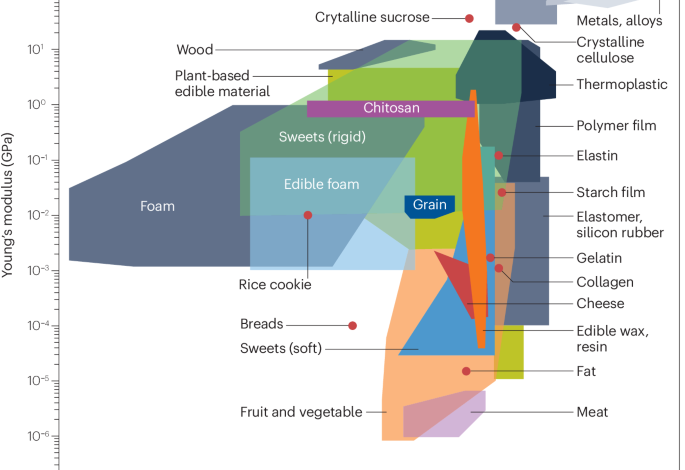Towards edible robots and robotic food

Rus, D. & Tolley, M. T. Design, fabrication and control of soft robots. Nature 521, 467–475 (2015).
Sethi, S. S., Kovac, M., Wiesemüller, F., Miriyev, A. & Boutry, C. M. Biodegradable sensors are ready to transform autonomous ecological monitoring. Nat. Ecol. Evol. 6, 1245–1247 (2022).
Hartmann, F., Baumgartner, M. & Kaltenbrunner, M. Becoming sustainable, the new frontier in soft robotics. Adv. Mater. 33, 2004413 (2021).
Lamanna, L., Cataldi, P., Friuli, M., Demitri, C. & Caironi, M. Monitoring of drug release via intra body communication with an edible pill. Adv. Mater. Technol. 8, 2200731 (2023).
Marik, P. E. Aspiration pneumonitis and aspiration pneumonia. N. Engl. J. Med. 344, 665–671 (2001).
Amirkolaie, A. K. Reduction in the environmental impact of waste discharged by fish farms through feed and feeding: aquaculture and the environment. Rev. Aquac. 3, 19–26 (2011).
Just Economics. Dead loss: the high cost of poor farming practices and mortalities on salmon farms. Changing Markets Foundation https://www.justeconomics.co.uk/uploads/reports/Aquaculture-Report-v5.pdf (2021).
Pohlmann, K., Grasso, F. W. & Breithaupt, T. Tracking wakes: the nocturnal predatory strategy of piscivorous catfish. Proc. Natl Acad. Sci. USA 98, 7371–7374 (2001).
Meng, X. J., Lindsay, D. S. & Sriranganathan, N. Wild boars as sources for infectious diseases in livestock and humans. Philos. Trans. R. Soc. B Biol. Sci. 364, 2697–2707 (2009).
Fraser, D. Toward a synthesis of conservation and animal welfare science. Anim. Welf. 19, 121–124 (2010).
Fraser, D. Understanding animal welfare. Acta Vet. Scand. 50, S1 (2008).
Ashby, M. F. Materials selection in mechanical design. MRS Bull. 30, 994–997 (1999).
Radhakrishnan, V. Locomotion: dealing with friction. Proc. Natl Acad. Sci. USA 95, 5448–5455 (1998).
Godshall, M. A., Eggleston, G., Thompson, J. & Kochergin, V. in Kirk-Othmer Encyclopedia of Chemical Technology 1–84 (Wiley, 2021).
Ramos, K. J. & Bahr, D. F. Mechanical behavior assessment of sucrose using nanoindentation. J. Mater. Res. 22, 2037–2045 (2007).
Eichhorn, S. J. & Young, R. J. The Young’s modulus of a microcrystalline cellulose. Cellulose 8, 197–207 (2001).
Sun, C. True density of microcrystalline cellulose. J. Pharm. Sci. 94, 2132–2134 (2005).
Keetels, C. J. A. M., van Vliet, T. & Walstra, P. Relationship between the sponge structure of starch bread and its mechanical properties. J. Cereal Sci. 24, 27–31 (1996).
Liu, Z. & Scanlon, M. G. Understanding and modeling the processing-mechanical property relationship of bread crumb assessed by indentation. Cereal Chem. 79, 763–767 (2002).
Shintake, J., Sonar, H., Piskarev, E., Paik, J. & Floreano, D. Soft pneumatic gelatin actuator for edible robotics. in 2017 IEEE/RSJ International Conference on Intelligent Robots and Systems (IROS) 6221–6226 (IEEE, 2017).
Kwak, B., Shintake, J., Zhang, L. & Floreano, D. Towards edible drones for rescue missions: design and flight of nutritional wings. in 2022 IEEE/RSJ International Conference on Intelligent Robots and Systems (IROS) 1802–1809 (IEEE, 2022).
Qi, Q., Keller, A., Tan, L., Kumaresan, Y. & Rossiter, J. Edible, optically modulating, shape memory oleogel composites for sustainable soft robotics. Mater. Des. 235, 112339 (2023).
Bourlieu, C., Guillard, V., Vallès-Pàmies, B. & Gontard, N. in Food Materials Science: Principles and Practice Ch. 23 (Springer, 2008).
Yuan, Y. et al. Shellac: a promising natural polymer in the food industry. Trends Food Sci. Technol. 109, 139–153 (2021).
Zhang, Y. et al. Functional food packaging for reducing residual liquid food: thermo-resistant edible super-hydrophobic coating from coffee and beeswax. J. Colloid Interface Sci. 533, 742–749 (2019).
Wang, D., Huang, J., Guo, Z. & Liu, W. Durable mixed edible wax coating with stretching superhydrophobicity. J. Mater. Chem. A 9, 1495–1499 (2021).
Wösten, H. A. B. & Scholtmeijer, K. Applications of hydrophobins: current state and perspectives. Appl. Microbiol. Biotechnol. 99, 1587–1597 (2015).
Maulana, M. I. et al. Environmentally friendly starch-based adhesives for bonding high-performance wood composites: a review. Forests 13, 1614 (2022).
Mukherjee, T., Lerma‐Reyes, R., Thompson, K. A. & Schrick, K. Making glue from seeds and gums: working with plant‐based polymers to introduce students to plant biochemistry. Biochem. Mol. Biol. Educ. 47, 468–475 (2019).
Doll, K. M. & Erhan, S. Z. Evaluation of a sugar-based edible adhesive using a tensile strength tester. J. Lab. Autom. 16, 153–156 (2011).
Román, J. K. & Wilker, J. J. Cooking chemistry transforms proteins into high-strength adhesives. J. Am. Chem. Soc. 141, 1359–1365 (2019).
Schmidt, G. et al. Strong adhesives from corn protein and tannic acid. Adv. Sustain. Syst. 3, 1900077 (2019).
Moubarik, A., Charrier, B., Allal, A., Charrier, F. & Pizzi, A. Development and optimization of a new formaldehyde-free cornstarch and tannin wood adhesive. Eur. J. Wood Prod. 68, 167–177 (2010).
North, M. A., Del Grosso, C. A. & Wilker, J. J. High strength underwater bonding with polymer mimics of mussel adhesive proteins. ACS Appl. Mater. Interfaces 9, 7866–7872 (2017).
Cataldi, P. et al. An electrically conductive oleogel paste for edible electronics. Adv. Funct. Mater. 32, 2113417 (2022).
Laschi, C., Mazzolai, B. & Cianchetti, M. Soft robotics: technologies and systems pushing the boundaries of robot abilities. Sci. Robot. 1, eaah3690 (2016).
Wei, M., Gao, Y., Li, X. & Serpe, M. J. Stimuli-responsive polymers and their applications. Polym. Chem. 8, 127–143 (2016).
Mirvakili, S. M. & Hunter, I. W. Artificial muscles: mechanisms, applications, and challenges. Adv. Mater. 30, 1704407 (2018).
Aubin, C. A. et al. Powerful, soft combustion actuators for insect-scale robots. Science 381, 1212–1217 (2023).
Baumgartner, M. et al. Resilient yet entirely degradable gelatin-based biogels for soft robots and electronics. Nat. Mater. 19, 1102–1109 (2020).
Sardesai, A. N. et al. Design and characterization of edible soft robotic candy actuators. MRS Adv. 3, 3003–3009 (2018).
Hughes, J. & Rus, D. Mechanically programmable, degradable & ingestible soft actuators. in 2020 3rd IEEE International Conference on Soft Robotics (RoboSoft) 836–843 (IEEE, 2020).
Ahn, S., Kasi, R. M., Kim, S.-C., Sharma, N. & Zhou, Y. Stimuli-responsive polymer gels. Soft Matter 4, 1151–1157 (2008).
Yang, Z. et al. Stimulus-responsive hydrogels in food science: a review. Food Hydrocolloids 124, 107218 (2022).
Djabourov, M., Nishinari, K. & Ross-Murphy, S. B. Physical Gels from Biological and Synthetic Polymers (Cambridge Univ. Press, 2013).
Keller, A. G., Qi, Q., Kumaresan, Y., Conn, A. T. & Rossiter, J. Biodegradable humidity actuators for sustainable soft robotics using deliquescent hydrogels. in 2023 IEEE International Conference on Soft Robotics (RoboSoft) 1–6 (IEEE, 2023).
Sarıyer, S., Duranoğlu, D., Doğan, Ö. & Küçük, İ. pH-responsive double network alginate/kappa-carrageenan hydrogel beads for controlled protein release: effect of pH and crosslinking agent. J. Drug Deliv. Sci. Technol. 56, 101551 (2020).
Shigemitsu, H. et al. An adaptive supramolecular hydrogel comprising self-sorting double nanofibre networks. Nat. Nanotechnol. 13, 165–172 (2018).
Ali, A. & Ahmed, S. Recent advances in edible polymer based hydrogels as a sustainable alternative to conventional polymers. J. Agric. Food Chem. 66, 6940–6967 (2018).
Fallingborg, J. Intraluminal pH of the human gastrointestinal tract. Dan. Med. Bull. 46, 183–196 (1999).
Tiwari, A. et al. in Stimuli-responsive polysaccharides for colon-targeted drug delivery Vol. 2, 547–566 (Woodhead Publishing, 2019).
Wang, W. et al. Transformative appetite: shape-changing food transforms from 2D to 3D by water interaction through cooking. in Proceedings of the 2017 CHI Conference on Human Factors in Computing Systems 6123–6132 (ACM, 2017).
Tao, Y. et al. Morphlour: personalized flour-based morphing food induced by dehydration or hydration method. in Proc. 32nd Annual ACM Symposium on User Interface Software and Technology 329–340 (ACM, 2019).
Tao, Y. et al. Morphing pasta and beyond. Sci. Adv. 7, eabf4098 (2021).
Sessini, V., Arrieta, M. P., Fernández-Torres, A. & Peponi, L. Humidity-activated shape memory effect on plasticized starch-based biomaterials. Carbohydr. Polym. 179, 93–99 (2018).
Chambers, L. D., Winfield, J., Ieropoulos, I. & Rossiter, J. Biodegradable and edible gelatine actuators for use as artificial muscles. in Proc. SPIE 9056, Electroactive Polymer Actuators and Devices (EAPAD) (ed. Bar-Cohen, Y.) (SPIE, 2014).
Zhu, X. et al. Ion-responsive chitosan hydrogel actuator inspired by carrotwood seed pod. Carbohydr. Polym. 276, 118759 (2022).
Yun, S., Kim, J. & Song, C. Performance of electro-active paper actuators with thickness variation. Sens. Actuators A Phys. 133, 225–230 (2007).
Rehman, H. M. M. U. et al. Edible rice paper-based multifunctional humidity sensor powered by triboelectricity. Sustain. Mater. Technol. 36, e00596 (2023).
Hou, S. et al. Ingestible, biofriendly, and flexible flour-based humidity sensors with a wide sensing range. ACS Appl. Electron. Mater. 3, 2798–2806 (2021).
Ilic, I. K. et al. Self-powered edible defrosting sensor. ACS Sens. 7, 2995–3005 (2022).
Kuswandi, B., Asih, N. P. N., Pratoko, D. K., Kristiningrum, N. & Moradi, M. Edible pH sensor based on immobilized red cabbage anthocyanins into bacterial cellulose membrane for intelligent food packaging. Packag. Technol. Sci. 33, 321–332 (2020).
Mallov, I., Jeeva, F. & Caputo, C. B. An edible genipin‐based sensor for biogenic amine detection. J. Chem. Tech. Biotech. 97, 830–836 (2022).
Court, R. C. V., Giesbers, G., Ostroverkhova, O. & Robinson, S. C. Optimizing xylindein from Chlorociboria spp. for (opto)electronic applications. Processes 8, 1477 (2020).
Costanza, V. et al. Effect of glycerol on the mechanical and temperature-sensing properties of pectin films. Appl. Phys. Lett. 115, 193702 (2019).
Di Giacomo, R., Bonanomi, L., Costanza, V., Maresca, B. & Daraio, C. Biomimetic temperature-sensing layer for artificial skins. Sci. Robot. 2, eaai9251 (2017).
Hardman, D., George Thuruthel, T. & Iida, F. Self-healing ionic gelatin/glycerol hydrogels for strain sensing applications. NPG Asia Mater. 14, 11 (2022).
Keller, A., Benz, D. & In Het Panhuis, M. Strain and pressure gauges from tough, conducting and edible hydrogels. MRS Proc. 1795, 27–33 (2015).
Annese, V. F., Galli, V., Coco, G. & Caironi, M. Eat, test, digest: towards diagnostic food for next-generation gastrointestinal tract monitoring. in 2023 9th International Workshop on Advances in Sensors and Interfaces (IWASI) 236–240 (IEEE, 2023).
Keller, A., Pham, J., Warren, H. & In Het Panhuis, M. Conducting hydrogels for edible electrodes. J. Mater. Chem. B 5, 5318–5328 (2017).
Xu, W. et al. Food-based edible and nutritive electronics. Adv. Mater. Technol. 2, 1700181 (2017).
Annese, V. F. et al. An edible bistable tilt sensor enabling autonomous operation of a partially eatable rolling robot. Adv. Sensor Res. 2, 2300092 (2023).
Ramadi, K. B. et al. Bioinspired, ingestible electroceutical capsules for hunger-regulating hormone modulation. Sci. Robot. 8, eade9676 (2023).
Tian, S. et al. A degradable-renewable ionic skin based on edible glutinous rice gel. ACS Appl. Mater. Interfaces 14, 5122–5133 (2022).
Lee, D. & Chua, B. Soft candy as an electronic material suitable for salivary conductivity-based medical diagnostics in resource-scarce clinical settings. ACS Appl. Mater. Interfaces 13, 43984–43992 (2021).
Ruiz-Valdepeñas Montiel, V. et al. Direct electrochemical biosensing in gastrointestinal fluids. Anal. Bioanal. Chem. 411, 4597–4604 (2019).
Kim, J. et al. Edible electrochemistry: food materials based electrochemical sensors. Adv. Healthc. Mater. 6, 1700770 (2017).
Fukada, K., Tajima, T. & Seyama, M. Food‐based capacitive sensors using a dynamic permittivity change with hydrogels responsive to hydrogen peroxide. Adv. Mater. Technol. 7, 2200830 (2022).
Steiger, C. et al. Ingestible electronics for diagnostics and therapy. Nat. Rev. Mater. 4, 83–98 (2019).
Seo, J. et al. Wireless electrical power delivery using light through soft skin tissues under misalignment and deformation. Adv. Mater. Interfaces 9, 2102586 (2022).
Zayats, V. V., Sergeev, I. K. & Fedorov, D. A. Review of promising methods of supplying power to implantable medical devices. Biomed. Eng. 57, 39–44 (2023).
Sharova, A. S., Melloni, F., Lanzani, G., Bettinger, C. J. & Caironi, M. Edible electronics: the vision and the challenge. Adv. Mater. Technol. 6, 2000757 (2021).
Saravanavel, G. et al. Sweet-tooth: resonators on sugar. IEEE J. Flex. Electron. https://doi.org/10.1109/JFLEX.2023.3273183 (2023).
Chen, K. et al. An edible and nutritive zinc-ion micro-supercapacitor in the stomach with ultrahigh energy density. ACS Nano 16, 15261–15272 (2022).
Hamilton, C. A., Alici, G. & In Het Panhuis, M. 3D printing vegemite and marmite: redefining “breadboards”. J. Food Eng. 220, 83–88 (2018).
Burch, R. R., Dong, Y.-H., Fincher, C., Goldfinger, M. & Rouviere, P. E. Electrical properties of polyunsaturated natural products: field effect mobility of carotenoid polyenes. Synth. Met. 146, 43–46 (2004).
Bouzidi, A. et al. Electronic conduction mechanism and optical spectroscopy of indigo carmine as novel organic semiconductors. Opt. Quant. Electron. 50, 176 (2018).
Irimia-Vladu, M. et al. Indigo — a natural pigment for high performance ambipolar organic field effect transistors and circuits. Adv. Mater. 24, 375–380 (2012).
Yakuphanoglu, F., Kandaz, M., Yaraşır, M. N. & Şenkal, F. B. Electrical transport and optical properties of an organic semiconductor based on phthalocyanine. Phys. B Condens. Matter 393, 235–238 (2007).
Giesbers, G. et al. Xylindein: naturally produced fungal compound for sustainable (opto)electronics. ACS Omega 4, 13309–13318 (2019).
Porrazzo, R. et al. Water-gated n-type organic field-effect transistors for complementary integrated circuits operating in an aqueous environment. ACS Omega 2, 1–10 (2017).
Sharova, A. S. & Caironi, M. Sweet electronics: honey‐gated complementary organic transistors and circuits operating in air. Adv. Mater. 33, 2103183 (2021).
Mandal, S. et al. Low operating voltage organic field-effect transistors with gelatin as a moisture-induced ionic dielectric layer: the issues of high carrier mobility. ACS Appl. Mater. Interfaces 12, 19727–19736 (2020).
Dumitru, L. M. et al. A hydrogel capsule as gate dielectric in flexible organic field-effect transistors. Apl. Mater. 3, 014904 (2014).
Preston, D. J. et al. Digital logic for soft devices. Proc. Natl Acad. Sci. USA 116, 7750–7759 (2019).
Rothemund, P. et al. A soft, bistable valve for autonomous control of soft actuators. Sci. Robot. 3, eaar7986 (2018).
Song, S., Joshi, S. & Paik, J. CMOS‐inspired complementary fluidic circuits for soft robots. Adv. Sci. 8, 2100924 (2021).
Deng, J. et al. Logic bonbon: exploring food as computational artifact. in CHI Conference on Human Factors in Computing Systems 1–21 (ACM, 2022).
Zhang, S., Kwak, B. & Floreano, D. Design and manufacture of edible microfluidic logic gates. in 2023 IEEE International Conference on Soft Robotics (RoboSoft) 1–7 (2023).
Ilic, I. K. et al. An edible rechargeable battery. Adv. Mater. 35, 2211400 (2023).
Kim, Y. J., Chun, S.-E., Whitacre, J. & Bettinger, C. J. Self-deployable current sources fabricated from edible materials. J. Mater. Chem. B 1, 3781 (2013).
Kim, Y. J., Wu, W., Chun, S.-E., Whitacre, J. F. & Bettinger, C. J. Biologically derived melanin electrodes in aqueous sodium-ion energy storage devices. Proc. Natl Acad. Sci. USA 110, 20912–20917 (2013).
Lamanna, L. et al. Edible cellulose-based conductive composites for triboelectric nanogenerators and supercapacitors. Nano Energy 108, 108168 (2023).
Wang, X. et al. Food-materials-based edible supercapacitors. Adv. Mater. Technol. 1, 1600059 (2016).
Gao, C. et al. A directly swallowable and ingestible micro-supercapacitor. J. Mater. Chem. A 8, 4055–4061 (2020).
Ieropoulos, I. A., Greenman, J., Melhuish, C. & Horsfield, I. Microbial fuel cells for robotics: energy autonomy through artificial symbiosis. ChemSusChem 5, 1020–1026 (2012).
Philamore, H., Rossiter, J., Stinchcombe, A. & Ieropoulos, I. Row-bot: an energetically autonomous artificial water boatman. in 2015 IEEE/RSJ International Conference on Intelligent Robots and Systems (IROS) 3888–3893 (IEEE, 2015).
Wilkinson, S. “Gastrobots” — benefits and challenges of microbial fuel cells in foodpowered robot applications. Auton. Robot. 9, 99–111 (2000).
Jeerapan, I. et al. Fully edible biofuel cells. J. Mater. Chem. B 6, 3571–3578 (2018).
Okui, M., Nagura, Y., Iikawa, S., Yamada, Y. & Nakamura, T. A pneumatic power source using a sodium bicarbonate and citric acid reaction with pressure booster for use in mobile devices. in 2017 IEEE/RSJ International Conference on Intelligent Robots and Systems (IROS) 1040–1045 (IEEE, 2017).
Ghosh, S. K., Park, J., Na, S., Kim, M. P. & Ko, H. A fully biodegradable ferroelectric skin sensor from edible porcine skin gelatine. Adv. Sci. 8, 2005010 (2021).
Cuadros, T. R., Erices, A. A. & Aguilera, J. M. Porous matrix of calcium alginate/gelatin with enhanced properties as scaffold for cell culture. J. Mech. Behav. Biomed. Mater. 46, 331–342 (2015).
Dekkers, B. L., Boom, R. M. & van der Goot, A. J. Structuring processes for meat analogues. Trends Food Sci. Technol. 81, 25–36 (2018).
Dankar, I., Haddarah, A., Omar, F. E. L., Sepulcre, F. & Pujolà, M. 3D printing technology: the new era for food customization and elaboration. Trends Food Sci. Technol. 75, 231–242 (2018).
Yang, H., Luo, D., Qian, K. & Yao, L. Freeform fabrication of fluidic edible materials. in Proc. 2021 CHI Conference on Human Factors in Computing Systems 1–10 (ACM, 2021).
Sun, J., Zhou, W., Huang, D., Fuh, J. Y. H. & Hong, G. S. An overview of 3D printing technologies for food fabrication. Food Bioprocess. Technol. 8, 1605–1615 (2015).
Gervasoni, S. et al. CANDYBOTS: a new generation of 3D-printed sugar-based transient small-scale robots. Adv. Mater. 32, e2005652 (2020).
van der Sman, R. G. M. & Broeze, J. Structuring of indirectly expanded snacks based on potato ingredients: a review. J. Food Eng. 114, 413–425 (2013).
Liu, Z., Zhang, M., Bhandari, B. & Wang, Y. 3D printing: printing precision and application in food sector. Trends Food Sci. Technol. 69, 83–94 (2017).
Navaf, M. et al. 4D printing: a new approach for food printing; effect of various stimuli on 4D printed food properties. A comprehensive review. Appl. Food Res. 2, 100150 (2022).
Teng, X., Zhang, M. & Mujumdar, A. S. 4D printing: recent advances and proposals in the food sector. Trends Food Sci. Technol. 110, 349–363 (2021).
Amit, S. K., Uddin, Md, M., Rahman, R., Islam, S. M. R. & Khan, M. S. A review on mechanisms and commercial aspects of food preservation and processing. Agric. Food Secur. 6, 51 (2017).
Khan, S., Lorenzelli, L. & Dahiya, R. S. Technologies for printing sensors and electronics over large flexible substrates: a review. IEEE Sens. J. 15, 3164–3185 (2015).
Boutry, C. M. et al. Biodegradable and flexible arterial-pulse sensor for the wireless monitoring of blood flow. Nat. Biomed. Eng. 3, 47–57 (2019).
Chyan, Y. et al. Laser-induced graphene by multiple lasing: toward electronics on cloth, paper, and food. ACS Nano 12, 2176–2183 (2018).
Gattass, R. R. & Mazur, E. Femtosecond laser micromachining in transparent materials. Nat. Photon 2, 219–225 (2008).
Leistner, L. Basic aspects of food preservation by hurdle technology. Int. J. Food Microbiol. 55, 181–186 (2000).
Kim, M. in Food Futures: Sensory Explorations in Food Design (eds Sweetapple, K. & Warriner, G.) 214–217 (Promopress, 2017).
Grover, W. H. CandyCodes: simple universally unique edible identifiers for confirming the authenticity of pharmaceuticals. Sci. Rep. 12, 7452 (2022).
Miyatake, Y., Punpongsanon, P., Iwai, D. & Sato, K. interiqr: unobtrusive edible tags using food 3D printing. in Proc. 35th Annual ACM Symposium on User Interface Software and Technology 1–11 (ACM, 2022).
Hitti, N. Erika Marthins uses edible robotics and digital data for sensory desserts. Dezeen https://www.dezeen.com/2018/01/20/erika-marthins-combines-edible-robotics-digital-data-and-food-to-create-sensory-desserts/ (2018).
Sun, W. et al. Biodegradable, sustainable hydrogel actuators with shape and stiffness morphing capabilities via embedded 3D printing. Adv. Funct. Mater. 33, 2303659 (2023).
Pratt, J., Radulescu, P. V., Guo, R. M. & Abrams, R. A. It’s alive!: animate motion captures visual attention. Psychol. Sci. 21, 1724–1730 (2010).
Spence, C. Why are animate dishes so disturbing? Int. J. Gastron. Food Sci. 13, 73–77 (2018).
Spence, C. & Youssef, J. On the rise of shocking food. Int. J. Gastron. Food Sci. 30, 100615 (2022).
Mochiyama, H., Ando, M., Misu, K. & Kuroyanagi, T. A study of potential social impacts of soft robots with organic and edible bodies by observation of an artwork. in 2019 IEEE International Conference on Advanced Robotics and its Social Impacts (ARSO) 208–212 (IEEE, 2019).
Ishii, A. & Siio, I. BubBowl: display vessel using electrolysis bubbles in drinkable beverages. in Proc. 32nd Annual ACM Symposium on User Interface Software and Technology 619–623 (ACM, 2019).
Van Doleweerd, E., Altarriba Bertran, F. & Bruns, M. Incorporating shape-changing food materials into everyday culinary practices: guidelines informed by participatory sessions with chefs involving edible pH-responsive origami structures. in Proceedings of Sixteenth International Conference on Tangible, Embedded, and Embodied Interaction 1–14 (ACM, 2022).
Burton, L. J., Cheng, N. & Bush, J. W. M. The cocktail boat. Integr. Comp. Biol. 54, 969–973 (2014).
Brodkorb, A. et al. INFOGEST static in vitro simulation of gastrointestinal food digestion. Nat. Protoc. 14, 991–1014 (2019).
Van de Wiele, T. et al. in The Impact of Food Bioactives on Health: In Vitro and Ex Vivo Models (eds Verhoeckx, K. et al.) 305–317 (Springer, 2015).
Smeets, P. A. M., Deng, R., van Eijnatten, E. J. M. & Mayar, M. Monitoring food digestion with magnetic resonance techniques. Proc. Nutr. Soc. 80, 148–158 (2021).
Buchner, T. J. K. et al. Vision-controlled jetting for composite systems and robots. Nature 623, 522–530 (2023).
Wehner, M. et al. An integrated design and fabrication strategy for entirely soft, autonomous robots. Nature 536, 451–455 (2016).
Lee, H. et al. 3D-printed programmable tensegrity for soft robotics. Sci. Robot. 5, eaay9024 (2020).
Nakata, Y. et al. Exploring the eating experience of a pneumatically-driven edible robot: perception, taste, and texture. PLoS ONE 19, e0296697 (2024).
Kotynia, R., Adamczewska, K., Strąkowska, A., Masłowski, M. & Strzelec, K. Effect of accelerated curing conditions on shear strength and glass transition temperature of epoxy adhesives. Procedia Eng. 193, 423–430 (2017).
Frihart, C. R. Are epoxy-wood bonds durable enough? in Wood Adhesives 2005 241–246 (Forest Products Society, 2005).
Henkel. LOCTITE®638TM technical data sheet. Henkel https://datasheets.tdx.henkel.com/LOCTITE-638-en_GL.pdf (2022).
Henkel. Loctite PL Premium Fast Grab technical data sheet. Henkel https://dm.henkel-dam.com/is/content/henkel/tds-us-loctite-loc-pl-premium-8x-fast-grab-2019-12-12 (2019).
Sikora, K. S., McPolin, D. O. & Harte, A. M. Shear strength and durability testing of adhesive bonds in cross-laminated timber. J. Adhes. 92, 758–777 (2016).
Wang, Z., Li, Z., Gu, Z., Hong, Y. & Cheng, L. Preparation, characterization and properties of starch-based wood adhesive. Carbohydr. Polym. 88, 699–706 (2012).
3M. 3M Hot Melt Adhesive technical data sheet. 3M https://multimedia.3m.com/mws/media/1245165O/3m-hot-melt-adhesive-3792lm-3776lm-3738-3792-technical-data.pdf (2016).
Wei, Y., Yao, J., Shao, Z. & Chen, X. Water-resistant zein-based adhesives. ACS Sustain. Chem. Eng. 8, 7668–7679 (2020).



